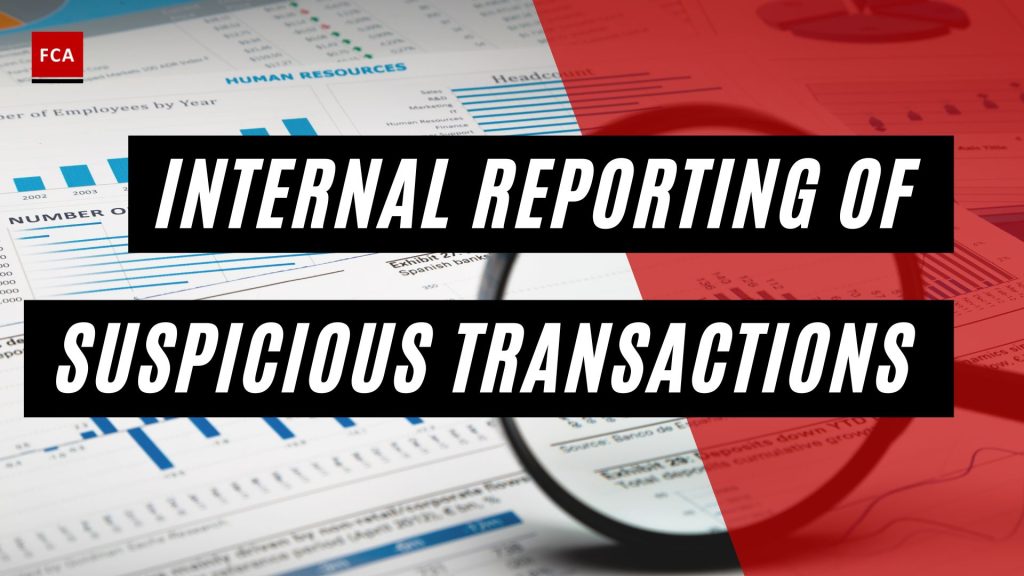Efficient internal reporting of suspicious transactions serves as a crucial pillar in maintaining financial integrity and mitigating the risk of fraudulent activities within a financial institution. The compliance investigation team and money laundering reporting officer or MLRO, are responsible to perform appropriate transaction investigations and ensure that facts and detail are shared with the senior management, including the Compliance Committee, for review and necessary feedback.
In an institution, internal reporting takes different forms and involves different hierarchies. Initially, the investigation report is prepared by the compliance investigation team, which is first shared with Money Laundering Reporting Officer (MLRO) for his or her review.

MLRO’s Internal Reporting of Suspicious Transactions
Concluding the investigation of trade-based money laundering or suspicious transaction should be appropriately based on the right evidence, and information gathered from various sources. The appropriate and relevant conclusions are necessary because the management should ensure that only suspicious transaction is reported to the FIU and that any clear or fair transaction is not reported as a suspicious transaction.
Conclusions drawn in the report should be backed by relevant data, information, evidence, policies, procedures, and applicable laws and regulations. When such a conclusion is drawn, the reviewer finds it easier to cross-refer the transaction and investigation process followed by the compliance team.
The internal reporting of suspicious transactions should highlight the reasons for trade transaction-related suspicions and the root causes. Before conclusion, the trade compliance team must ensure that all relevant trade transactions related to money laundering and terrorist financing risks are assessed and evaluated.
The conclusion should also highlight the weaknesses of internal trade compliance policies and procedures, that caused the occurrence of a trade-related suspicious transaction, such as old KYCs, irrelevant trade transaction thresholds used for monitoring, outdated trade compliance policies, etc.
The trade transaction investigation conclusion depends on the authority and maturity of the Trade Anti-Money Laundering (AML) team and the MLRO, who were involved in the investigation process. Subject matter experts may be required for complex trade-related money laundering investigations, and such subject matter experts may include lawyers, senior trade operations staff, etc. to ensure that the right investigation is performed, as per the Trade related AML/CFT laws, regulations, policies, and procedures.

The investigation process and conclusion may require the experts to publicly source the required information concerning the individuals, employees, and entities that are suspected of involvement in the financial crime incident or activities. Identification of the right suspects makes the financial crime identification process easier and more structured.
The crime investigation team is required to quickly identify, ownership structure, directors and Management profiles, negative media searches, bankruptcy and disqualifications, previous court cases and judgments, asset profiles and locations, and internal controls and processes.
For the appropriate conclusion of the transaction investigation, the identification of ML/TF risk indicators and the history of similar cases play essential roles. Different categories of skill sets are used during the investigation.
A conclusion should reflect the involvement of law enforcement authorities in the investigation process (if any) because authorities may also take part in the investigation of a particular or significant suspicious transaction and may require evidence for their review.
After the review of the Trade MLRO, the report is to be shared with the Compliance Head for review and final feedback. The Compliance Head must ensure that the investigation report and conclusions drawn are based on facts and figures. After ensuring the reasonableness of the investigation report, the Compliance Head presents the report to the members of the Compliance Committee for review and discussion on the significant trade-related money laundering and terrorist financing incidents.
Compliance Committee performs a detailed review and provides necessary feedback to the department heads and the compliance head. The Compliance Committee on the recommendation of the Compliance Head decides to file the suspicious transaction report with the regulator.

Final Thoughts
Internal reporting of suspicious transactions in financial institutions is critical for maintaining financial integrity and deterring illicit activities. Ensuring accurate conclusions drawn from comprehensive investigations by the compliance team and the Money Laundering Reporting Officer (MLRO) allows senior management to act effectively. Conclusions must be evidence-based, highlight the root causes of suspicions, and underline any weaknesses in the internal trade compliance policies.
The meticulous investigation process involves subject matter experts, ML/TF risk indicator identification, and historical case analysis. Ultimately, after the Compliance Head’s review and the Compliance Committee’s scrutiny, a suspicious transaction report is filed with the regulator, thereby ensuring a vigilant and secure financial environment.








